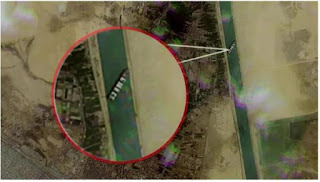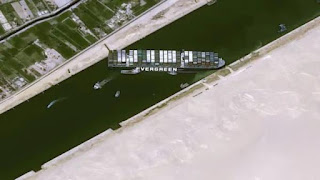Suez Canal Crisis: Only one boat is used to block the Eurasian Channel! How can Evergreen's giant ship in the Suez Canal get out of trouble?
Today, the Suez Canal is stuck, causing serious obstruction. At present, at least 100 ships on the Suez Canal cannot travel between the Red Sea and the Mediterranean. The canal cannot resume normal operations for the time being, which may have an impact on global logistics.
The freighter named "Ever Given" (Ever Given) is manufactured and owned by Imabari Shipbuilding in Japan and operated by Evergreen Shipping Group in Taiwan. It was originally planned to sail from China to the Dutch port city of Rotterdam, but stranded on the Suez Canal on the way to the Mediterranean.
The stranded cargo ship is about 400 meters in length, 59 meters in width, and has a transport capacity of 224,000 tons. It is one of the largest container ships in the world. It ran aground while entering the new channel of the Suez Canal on the 23rd.
More than 100 ships are as the traverse was completely blocked by the huge ship. The cause of the stranding is said to be a sudden gust of wind.
Regarding the cause of the ship stranding, Rabie, chairman of the Suez Canal Authority, said that in addition to the sandstorms and strong winds mentioned, there may also be reasons such as technical failures and human factors of the freighter.
The 400-meter-long Ever Given ran aground diagonally across the single-lane stretch of the southern canal on Tuesday morning after losing the ability to steer amid high winds and a dust storm, the Suez Canal Authority said in a statement.
The Egyptian side has formulated multiple rescue plans for the stranded freighter.
The first thing to do is to clear the silt, dig out the sand and sand from the bow and stern, and let the giant ship float as much as possible.
What is worth looking forward to is that the tides in the last two days will reach its maximum, which greatly increases the chance of getting out of the water.
Looking at it now, we can only wait for the high tide of the sea this weekend to see if we can get out of trouble with the help of nature.
If it doesn't work, you can only unload the cargo, and it won't take a day or two.
After two days of hard work, the good news is that the stern is now basically out of trouble, but the bow is still partially trapped in the sand.
More than 160 ships are waiting at both ends of the waterway. From Asia to Europe, passing the Suez Canal is the only option.
The paralysis of the waterway has led to rising oil prices in the international market, and a large amount of oil and natural gas must pass through this waterway.
Located in Egypt, it is the main international shipping route connecting the three continents of Europe, Asia and Africa, connecting the Red Sea and the Mediterranean, connecting the Atlantic, the Mediterranean and the Indian Ocean, greatly shortening the east-west voyage.
The other main route is to bypass the Cape of Good Hope at the southern tip of Africa, but this will take much longer.
The blockage of the Suez Canal will cause Europe to delay receiving parts and raw materials for a range of products, including cotton from India, oil and clothing from the Middle East, and plastics and auto parts from China.
The incident has less direct impact on the United States, because most of the goods shipped from Asia to the United States take the Pacific route. But some products will be affected, because some Asian parts must be sent to Europe for assembly before being shipped to the United States.
It is estimated that the canal is paralyzed and stuck with goods worth 9.6 billion U.S. dollars every day. Among them, cargo ships traveling westward are carrying goods worth about 5.1 billion U.S. dollars, while ships traveling eastward are carrying goods worth about 4.5 billion U.S. dollars. In addition, the itinerary of empty cargo ships returning to Asia is also affected.






Comments
Post a Comment